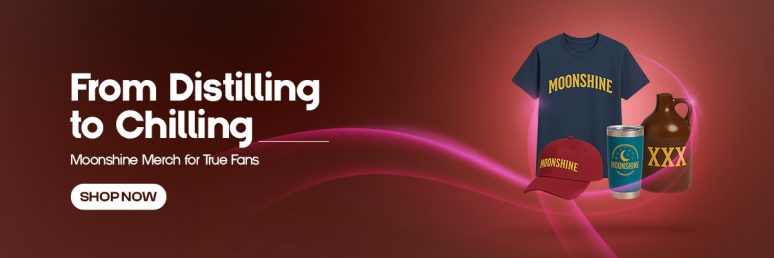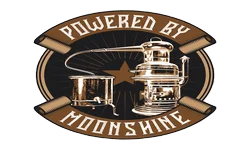Does Moonshine Improve with Age? What People Commonly Ask
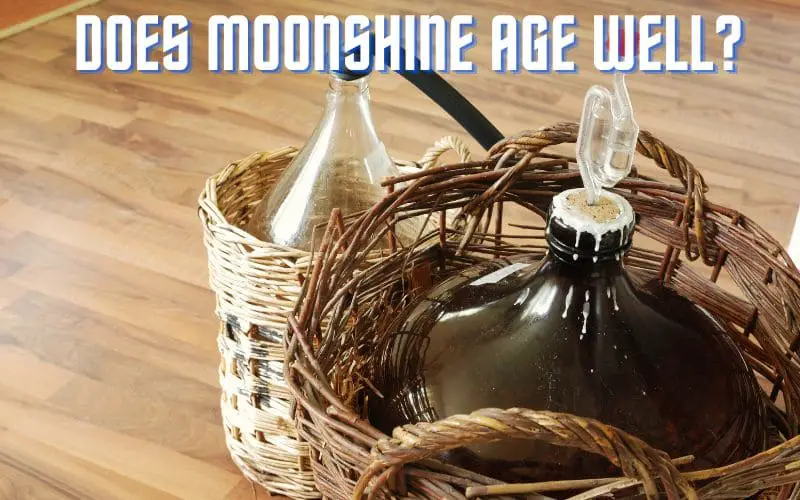
Article-at-a-Glance
- Traditional moonshine can improve with age when stored in the right containers, particularly charred oak barrels that impart flavor compounds and color.
- Different types of moonshine age differently – corn-based varieties typically benefit more from aging than sugar shine or fruit-based varieties.
- Aging moonshine is essentially converting it into whiskey through chemical interactions with wood that add complexity and smoothness.
- The aging process for moonshine is much faster in small barrels, with noticeable changes occurring in weeks rather than the years required for commercial whiskey.
- While aging can improve moonshine’s taste, it cannot fix fundamental flaws in poorly distilled spirits or make dangerous moonshine safe to consume.
Moonshine, historically known as unaged homemade whiskey, has long been associated with clear, high-proof spirits that pack a serious punch. But as craft distilling grows in popularity, more enthusiasts are asking whether this notorious spirit might mellow and improve with time like its commercial cousins. The answer isn’t as straightforward as you might think, with several factors determining whether your ‘shine will transform into something special or simply remain the same spirit in an older jar.
The truth is that moonshine can indeed improve with age, but only under specific conditions and with proper techniques. The transformation depends largely on the storage container, the base ingredients used in distillation, and the quality of the initial spirit. When done correctly, aging can convert raw moonshine into something resembling a fine whiskey, with added complexity, color, and a significantly smoother drinking experience.
What Really Happens When Moonshine Ages

“Moonshine | The Nobler Experiment” from thenoblerexperiment.wordpress.com and used with no modifications.
At its core, aging moonshine is essentially the process of turning it into whiskey. Commercial whiskeys spend years in wooden barrels developing their characteristic amber color and complex flavor profiles. When you age moonshine, you’re initiating the same transformation, just typically on a smaller scale and often at a faster rate.
The aging process fundamentally changes moonshine through extraction, oxidation, and evaporation. When stored in wood (particularly oak), the spirit extracts compounds like vanillin, tannins, and various wood sugars that contribute flavor, aroma, and color. These compounds work together to mask the harsh ethanol edge of fresh moonshine, adding layers of complexity that simply weren’t there before.
What many enthusiasts don’t realize is that home-aged moonshine can evolve remarkably quickly compared to commercial spirits. This accelerated aging occurs because smaller barrels have a higher wood-to-spirit ratio, meaning more surface area contact between the liquid and wood. A small 2-5 liter barrel might create noticeable changes in just 2-4 weeks, while the same transformations would take years in traditional 53-gallon barrels used by commercial distilleries.
Types of Moonshine and Their Aging Potential

“Barrel Char in a Jar (Barrel-Aging …” from www.moodymixologist.com and used with no modifications.
Not all moonshine is created equal when it comes to aging potential. The base ingredients used in distillation significantly impact how the spirit will respond to the aging process, with some varieties showing dramatic improvement and others gaining only minimal benefits.
Corn-Based Moonshine
Traditional corn-based moonshine, often made with a mash bill similar to bourbon (at least 51% corn), generally responds exceptionally well to aging. The corn provides a natural sweetness that, when combined with wood-derived compounds, creates a rich and complex flavor profile reminiscent of commercial bourbon or whiskey. During aging, the harsh corn fusel alcohols tend to mellow considerably, and the spirit takes on pleasing notes of vanilla, caramel, and baking spices from the wood. For those interested in learning more about the process, you can explore how to age moonshine at home.
If your goal is to create a homemade whiskey through aging, starting with a corn-based moonshine provides the best foundation. Many home distillers report that even low-quality corn shine can be dramatically improved through proper aging, making this variety the most forgiving for aging experiments.
Sugar Shine
Sugar shine (sometimes called “sugar jack” or “ruckus juice”) is moonshine made primarily from sugar rather than grain. This type of moonshine typically has a cleaner, more neutral flavor profile since it lacks the grain elements that contribute to whiskey’s complexity. When aged, sugar shine will take on color and some wood characteristics, but the transformation is less profound than with corn-based varieties.
Fruit-Based Moonshine
Fruit-based moonshine, often called “brandy” when made properly, offers unique aging characteristics. These spirits, distilled from fermented fruits like apples, peaches, or berries, already possess complex flavor profiles before aging begins. When stored in wood, fruit-based moonshine can develop remarkable depth, with the fruit notes becoming more concentrated and complemented by the vanilla and spice notes from the barrel.
However, delicate fruit flavors can sometimes be overwhelmed by aggressive wood extraction, so aging fruit moonshine typically requires a more careful approach. Many home distillers find that shorter aging periods or using previously used barrels provides better results with fruit-based spirits. The goal is to enhance rather than mask the natural fruit character.
The Science Behind Moonshine Aging

“Age Your Own Whiskey, Moonshine, and …” from moonshinedistiller.com and used with no modifications.
Understanding the chemistry behind aging helps explain why moonshine changes so dramatically during the process. When unaged spirits meet wood, a complex series of interactions begins that transforms both the flavor and mouthfeel of the liquor. These changes occur through multiple simultaneous processes that work together to mellow the harsh edges of fresh moonshine.
Chemical Reactions During Aging
The most significant chemical changes during aging involve the extraction of compounds from wood and their subsequent transformation through oxidation. Oak contains hundreds of extractable compounds, with the most influential being lignin (which breaks down into vanillin), hemicellulose (providing sweetness and body), and various tannins (contributing structure and astringency). As moonshine absorbs these compounds, they interact with the alcohol and each other, creating new flavor molecules that weren’t present in either the original spirit or the wood.
Esterification is another crucial reaction that occurs during aging. This process combines alcohols with acids to form esters – compounds responsible for many of the fruity, floral notes in aged spirits. Esterification happens slowly at room temperature but can be accelerated by temperature fluctuations, which is why traditional whiskey warehouses aren’t climate-controlled. For home distillers, storing aging moonshine where it will experience natural temperature variations can help develop these desirable ester compounds.
Role of Oxygen in Flavor Development
Oxygen plays a pivotal role in the maturation of moonshine. Wooden barrels are semi-permeable, allowing tiny amounts of oxygen to enter and interact with the spirit. This controlled oxidation helps eliminate harsh sulfur compounds while promoting beneficial chemical reactions that develop flavor. The oxygen also facilitates the conversion of certain compounds into softer, more pleasing derivatives – for instance, converting sharp-tasting aldehydes into smoother acids and esters.
Glass containers, in contrast, are impermeable to oxygen. This is why moonshine aged in glass with wood chips develops differently than barrel-aged spirits. Without the slow ingress of oxygen, certain chemical reactions simply don’t occur. This doesn’t mean glass aging can’t improve moonshine, but it does produce a different flavor profile than traditional barrel aging.
How Impurities Change Over Time
Raw moonshine often contains impurities known as congeners – alcohols other than ethanol, aldehydes, esters, and various organic compounds. Some of these contribute desirable flavors, while others create harsh notes or unpleasant aromas. During aging, many of the harsher congeners undergo chemical changes that render them more palatable. The wood itself also acts as a filter, absorbing some undesirable compounds while contributing pleasant ones. For more insights on this process, you can explore the differences in aging moonshine in glass vs oak.
This transformation of impurities explains why properly aged moonshine is smoother than fresh spirit. However, it’s important to note that aging cannot remedy serious flaws in distillation. If moonshine contains dangerous levels of methanol or other toxic compounds, aging will not make it safe to consume. Quality aging starts with quality distillation.
Proof Changes During Aging
Alcohol proof typically decreases during aging due to evaporation. This phenomenon, known as the “angel’s share” in commercial distilling, occurs as alcohol molecules escape through the semi-porous wood. In traditional whiskey warehouses, the angel’s share can account for 2-5% loss per year. For home distillers using small barrels, this evaporation happens much faster and can significantly reduce proof over just a few months.
Interestingly, the evaporation isn’t uniform – alcohol and water evaporate at different rates depending on environmental conditions. In humid environments, alcohol evaporates faster than water, lowering the proof. In dry environments, water evaporates faster, potentially increasing the proof. Most home aging environments fall somewhere in between, with a net reduction in proof over time that contributes to a mellower, more approachable spirit.
The “Angel’s Share” in Home Aging
When aging moonshine in a 2-liter oak barrel at room temperature, you can expect to lose approximately:
- Week 1-2: 2-3% of volume
- Months 1-3: 8-12% of volume
- Months 4-6: 15-20% of volume
These losses accelerate in smaller barrels and warmer environments. Plan accordingly when aging valuable spirits!
Best Containers for Aging Moonshine
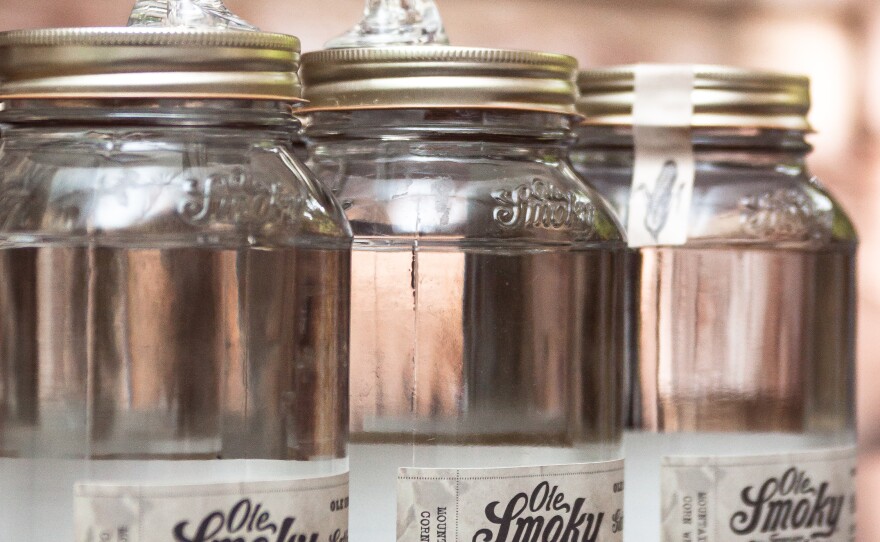
“Moonshine As Moneymaker? Eastern …” from www.kpbs.org and used with no modifications.
The container you choose for aging has perhaps the greatest impact on how your moonshine will develop over time. Each material interacts differently with the spirit, producing distinct flavor profiles and aging trajectories. The choice of container should align with your desired end result and the characteristics of your base moonshine.
Charred Oak Barrels
Charred oak barrels represent the gold standard for aging moonshine, particularly if your goal is to create a whiskey-like product. New charred oak imparts the richest flavor profile, with pronounced vanilla, caramel, and spice notes developing relatively quickly. The charring process caramelizes wood sugars and creates a layer of activated carbon that helps filter out harsh compounds while contributing pleasant flavors. For more information on aging moonshine, check out this guide on aging moonshine at home.
For home distillers, mini oak barrels (1-5 liters) provide an excellent aging vessel with accelerated results. Due to their higher surface-area-to-volume ratio, these small barrels can impart oak characteristics in weeks rather than years. However, this rapid aging requires careful monitoring, as over-oaking can happen quickly. Many enthusiasts find that 4-8 weeks in a new charred mini barrel produces optimal results for corn-based moonshine.
Glass Containers
Glass containers with added wood chips or staves offer a more controlled aging environment. While glass doesn’t allow for the oxygen exchange that occurs in barrels, it provides complete visibility of your aging spirit and eliminates evaporation losses. This method gives you precise control over the amount of wood contact, allowing you to add or remove wood pieces to fine-tune the flavor development.
When using this method, lightly toasted or charred oak chips, spirals, or cubes can be added directly to mason jars or glass jugs containing moonshine. Many home distillers recommend using about 1-2 tablespoons of oak chips per quart of spirit. The glass-and-wood method typically requires a bit more patience than barrel aging, with optimal results often taking 2-3 months to develop.
Stainless Steel
Stainless steel containers with added wood provide a hybrid aging solution. Like glass, stainless steel is non-reactive and doesn’t contribute flavors of its own, but it offers better temperature conductivity, which can slightly accelerate certain aging reactions. Some enthusiasts use stainless steel flasks or growlers with added wood pieces to age their moonshine.
The primary advantage of stainless steel is its durability and ease of cleaning, making it ideal for multiple aging experiments. However, like glass, it doesn’t allow for oxygen exchange, so the aging profile differs somewhat from traditional barrel aging. Stainless steel containers with wood additions typically produce results similar to the glass method, with noticeable flavor development occurring over 2-3 months.
Ceramic Jugs
Traditional ceramic jugs offer an interesting middle ground for aging moonshine. While not as porous as wood, quality ceramic allows for minimal oxygen exchange while being completely neutral in terms of flavor contribution. This makes ceramic particularly suitable for aging fruit-based moonshine where subtle oxidation is desired without heavy wood influence.
When using ceramic, wooden elements can still be added for flavor development. The aging process in ceramic typically progresses more slowly than in barrels but faster than in completely sealed glass containers. For best results, ceramic aging usually requires 3-6 months, with the spirit developing a slightly different character than barrel or glass-aged versions.
How Long Should You Age Moonshine?
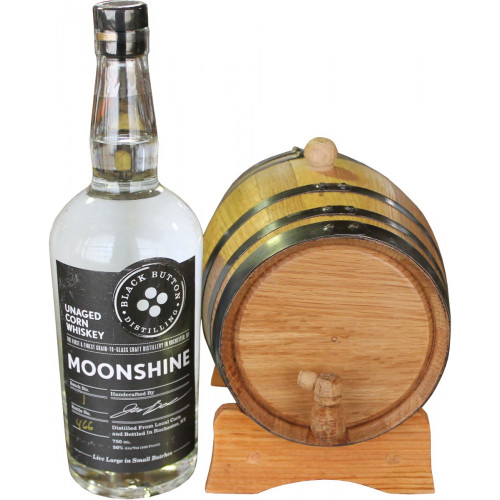
“Distillery Barrel Aging Kit …” from www.caskers.com and used with no modifications.
The ideal aging duration depends on multiple factors including the container type, the base spirit, and your flavor preferences. Unlike commercial whiskey that might age for years or decades, home-aged moonshine typically reaches its peak much more quickly due to the accelerated extraction in smaller containers.
Short-Term Aging (1-4 Weeks)
For moonshine in new charred mini barrels, significant changes begin almost immediately. After just one week, the harsh edge starts to soften and light amber color develops. By 2-4 weeks, many corn-based moonshines have taken on considerable color and woody flavors, with the spirit beginning to resemble a young commercial whiskey. This short-term aging works particularly well for higher-proof spirits (100-120 proof), which extract wood compounds more efficiently.
Short-term aging is ideal for those seeking a quick transformation of raw moonshine into a more approachable spirit. However, the flavor profile at this stage tends to be dominated by wood extraction rather than the more complex chemical changes that occur with longer aging.
Medium-Term Aging (1-6 Months)
The 1-6 month range represents the sweet spot for many home-aged moonshines. During this period, the initial woody extraction begins to integrate more harmoniously with the base spirit, and oxidation reactions create greater complexity. By 3-6 months in barrels (or 4-6 months with wood chips in glass), many home distillers report that their moonshine has developed a balanced profile with noticeable smoothness and depth. For those interested in exploring this further, you can learn more about aging moonshine at home.
This medium-term aging works well for all container types but requires occasional tasting to prevent over-oaking, particularly in small barrels. Many enthusiasts find that diluting the spirit to 80-100 proof before aging in this timeframe provides more balanced extraction and integration of flavors. For more details on the process, you can explore aging moonshine effectively.
Long-Term Experiments (6+ Months)
Aging moonshine beyond six months enters experimental territory for home distillers. In small new barrels, extended aging often leads to over-extraction, with bitter tannins and excessive oak dominating the flavor profile. However, in glass with minimal wood, or in barrels that have already been used several times (reducing their extraction rate), extended aging can produce remarkably complex spirits.
Those pursuing long-term aging should consider transferring moonshine from barrels to glass after a few months to prevent over-oaking, or starting with used barrels that impart flavor more gradually. Long-term aging also benefits from slightly lower storage temperatures (60-65°F) to slow extraction while still allowing beneficial oxidation reactions.
Common Moonshine Aging Mistakes to Avoid
Even the highest quality moonshine can be ruined during the aging process if certain common pitfalls aren’t avoided. Understanding these potential mistakes can help ensure your aging experiment results in a delicious mature spirit rather than an expensive disappointment.
Using the Wrong Container
Matching your container to your moonshine type and desired outcome is crucial. Using heavily charred new oak for delicate fruit spirits often results in overwhelming wood flavors that mask the fruit character. Conversely, trying to create a whiskey-like profile using neutral containers or insufficient wood contact will yield disappointing results. Consider your end goal carefully when selecting aging vessels, and don’t be afraid to experiment with different approaches for different batches.
Improper Storage Conditions
Temperature fluctuations play a significant role in the aging process, but extremes can damage your moonshine. Storing aging spirits in places that reach high temperatures (above 80°F) accelerates extraction to the point where bitter tannins dominate, while freezing temperatures can halt beneficial chemical reactions entirely. The ideal aging environment maintains temperatures between 60-75°F with natural daily fluctuations that encourage interaction between the spirit and wood without forcing excessive extraction.
Starting with Low-Quality Spirits
Perhaps the most common mistake is expecting aging to transform poor-quality moonshine into premium spirits. While aging can improve many characteristics, it cannot fix fundamental flaws in distillation. A spirit with excessive methanol, high levels of fusel oils, or contamination from improper cuts during distillation will not magically become clean and smooth through aging. Starting with the cleanest, best-distilled moonshine possible provides the foundation for successful aging.
Safety Considerations for Aged Moonshine
Safety should always be the primary concern when producing and aging homemade spirits. While commercial distilleries operate under strict regulations that ensure consumer safety, home distillers must be particularly vigilant about potential hazards.
Properly produced and aged moonshine can be perfectly safe to consume, but knowledge of specific risks is essential for anyone experimenting with aging their own spirits.
Methanol Concerns
Contrary to popular belief, aging does not eliminate methanol from moonshine. Methanol, a toxic alcohol that can cause blindness or death even in small quantities, must be removed during the distillation process through proper temperature control and discarding the “foreshots” (first portion of the distillate). If a spirit contains dangerous levels of methanol before aging, it will remain dangerous regardless of how long it ages. For those interested in exploring more about aging beverage production, it’s crucial to understand the science behind it.
The good news is that properly distilled spirits contain only trace amounts of methanol well below harmful levels. If you’re aging purchased commercial “moonshine” (which is actually legally produced unaged whiskey), methanol concerns are non-existent as these products are regulated for safety. For more information on this process, you can explore aging moonshine techniques and their effects.
Bacterial Contamination Risks
High-proof spirits are generally hostile environments for bacteria and other microorganisms due to their alcohol content. However, aging introduces new variables, particularly when using wooden barrels that may harbor microbes. To minimize contamination risks, all aging containers should be properly sanitized before use, and spirits should generally maintain a proof of at least 80 (40% alcohol) throughout the aging process.
One particular concern is the development of acetic acid bacteria, which can convert alcohol to vinegar when exposed to oxygen. This is rarely a safety issue but can ruin the flavor of your aged spirit. Using properly sealed containers and maintaining appropriate alcohol levels helps prevent this problem.
Legal Aspects of Making and Aging Moonshine
It’s impossible to discuss moonshine without addressing the legal implications. In the United States, distilling spirits at home without proper permits remains illegal at the federal level, regardless of quantity or whether it’s for personal consumption. The penalties can include hefty fines and even imprisonment. This prohibition stems from both tax revenue concerns and safety considerations related to the distillation process.
That said, aging commercially produced unaged whiskey (often marketed as “white whiskey” or legal “moonshine”) is perfectly legal and provides a safer alternative for those interested in experimenting with the aging process. Many craft distilleries now sell unaged spirits specifically for home aging experiments, along with mini barrels and aging kits. This approach allows enthusiasts to experience the transformation from clear spirit to amber whiskey without legal concerns.
The Bottom Line: When Aging Improves Moonshine and When It Doesn’t
Aging generally improves traditional corn-based moonshine, transforming it into something resembling whiskey with added complexity, smoother mouthfeel, and pleasant wood-derived flavors. The improvement is most dramatic in spirits that are clean but characterful to begin with – those with good corn notes but perhaps a bit too much fire. However, aging won’t perform miracles on poorly made spirits, and some varieties (particularly neutral sugar shine) may gain less from the process than others. The best approach is to start with quality distillate, use appropriate aging vessels, and monitor the evolution of your spirit through regular tasting.
Frequently Asked Questions
As the interest in home aging spirits grows, certain questions repeatedly arise from enthusiasts looking to create their own aged moonshine. Here are answers to some of the most common inquiries.
Can all types of moonshine be aged successfully?
While technically any distilled spirit can be aged, not all moonshine varieties benefit equally from the process. Grain-based moonshines (especially corn-heavy recipes) typically show the most dramatic improvement, developing whiskey-like characteristics with vanilla, caramel, and spice notes. Sugar-based moonshine, being more neutral in flavor, gains color and some wood notes but generally develops less complexity than grain-based spirits. Fruit brandies can age beautifully but often benefit from gentler wood contact to maintain their fruit character.
For the best aging results, start with a spirit that has good flavor on its own but could use softening and complexity. Completely neutral spirits or those with significant flaws will show less impressive transformation.
Does aging remove the “burn” from moonshine?
Aging significantly reduces the perceived burn of moonshine, but through multiple mechanisms rather than actually changing the alcohol content. The wood compounds mask the ethanol burn, various harsh congeners convert to smoother derivatives, and the slight reduction in proof from evaporation all contribute to a smoother drinking experience. Most home distillers report that properly aged moonshine loses the harsh, fiery character of the original spirit, replacing it with a warmer, more pleasant heat that enhances rather than overwhelms the flavor.
How can I tell if my aged moonshine has gone bad?
Unlike wine or beer, distilled spirits rarely “go bad” in a way that makes them unsafe, but they can develop unpleasant flavors. Signs that your aging experiment has taken a wrong turn include the development of vinegar-like aromas (indicating acetic acid bacteria activity), muddy or cloudy appearance that doesn’t clear with filtration, or extremely bitter, medicinal flavors from over-extraction of wood. Trust your senses – if the aged spirit smells unpleasant or tastes worse than when you started, something has gone wrong. For more insights on aging, check out this guide on aging moonshine.
To avoid spoilage, always use clean equipment, maintain appropriate alcohol levels (preferably above 40% ABV), and store aging containers in temperature-controlled environments away from direct sunlight. Regular tasting throughout the aging process allows you to catch and address any developing issues before they ruin your spirits.
If you’re fascinated by the transformation of raw moonshine into smooth, complex spirits through the magic of aging, Redhead Oak Barrels offers a complete selection of home aging barrels and accessories designed specifically for enthusiasts. Their American white oak barrels come in sizes perfect for home aging experiments, allowing you to create your own aged whiskey with professional results. Visit Redhead Oak Barrels today to start your journey into the world of spirit aging.

